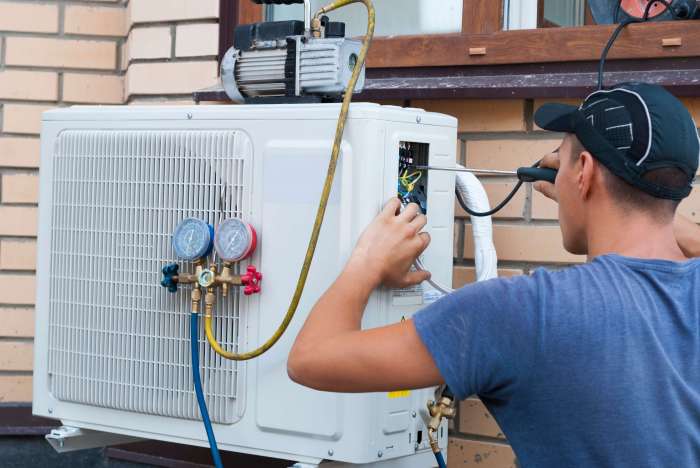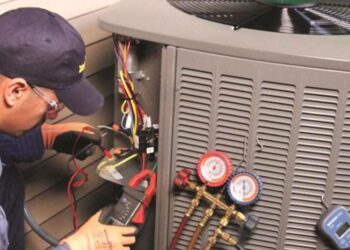Embark on a journey to discover the essential steps for preparing your home for air conditioner installation. This guide will delve into key aspects such as ideal locations, electrical setup, structural support, and sealing gaps to ensure a smooth and efficient installation process.
Before you welcome the cool breeze of a new air conditioner, make sure your home is ready to embrace this upgrade seamlessly.
Preparing the Space
When preparing the space for air conditioner installation, it is essential to ensure that the location is ideal, the area is clear, the measurements are accurate, and there is proper ventilation around the unit.
Ideal Location for Installation
When choosing the location for your air conditioner, opt for a spot that is close to an electrical outlet and away from direct sunlight or heat sources. This will help the unit operate more efficiently and maintain a comfortable temperature in the room.
Clearing the Area
Before installation, clear the area around the chosen location of any obstructions such as furniture, decor, or plants. This will make it easier for the technicians to install the unit properly and ensure optimal performance.
Measuring the Space
To measure the space for the air conditioner, use a tape measure to determine the width, height, and depth of the area where the unit will be installed. This will help you choose the right size unit for the space and avoid any issues during installation.
Importance of Proper Ventilation
Proper ventilation around the air conditioner is crucial for its efficiency and longevity. Ensure that there is enough space around the unit for air to circulate freely, allowing it to cool the room effectively without overheating.
Ensuring Proper Electrical Setup
When it comes to installing an air conditioner, ensuring the proper electrical setup is crucial for the safety and efficiency of the unit. Here's what you need to know about the electrical requirements for your air conditioner installation.
Checking Existing Wiring Compatibility
Before installing your air conditioner, it's important to check if your existing wiring is compatible with the electrical requirements of the unit. Make sure to inspect the circuit breaker and wiring to ensure they can handle the load of the air conditioner.
Installing a Dedicated Circuit
If your existing wiring is not compatible or you need to install a new air conditioner in a different location, you may need to install a dedicated circuit for the unit. This will ensure that the air conditioner has its own power source and is not overloaded by other appliances in the house.
Importance of Hiring a Qualified Electrician
It is highly recommended to hire a qualified electrician to handle the electrical setup for your air conditioner installation. A professional electrician will ensure that the wiring is done correctly, the circuit is properly installed, and all safety measures are taken to prevent any electrical hazards.
Checking for Structural Support
When installing an air conditioner, it is crucial to ensure that the structure of your home can support the weight of the unit. Failure to do so can result in damage to your property or even injury. Here are some tips to help you assess and reinforce the installation area if necessary.
Assessing the Structure
Before installing the air conditioner, make sure to check if the wall or window where the unit will be placed is strong enough to support its weight. Consider consulting a professional if you are unsure about the structural integrity of the installation area.
Reinforcing the Installation Area
- Consider adding additional support brackets or braces to reinforce the area where the air conditioner will be installed.
- Reinforcing the structure with plywood or metal plates can also help distribute the weight of the unit more evenly.
Types of Mounts
There are different types of mounts available for air conditioner installation, such as wall mounts, window mounts, and through-the-wall mounts. Choose the one that best suits your needs and the structure of your home.
Securing the Unit
- Make sure to secure the air conditioner properly to prevent accidents. Follow the manufacturer's instructions for installation and use brackets or screws to secure the unit in place.
- Regularly check the unit to ensure it is securely fastened and make any necessary adjustments to prevent it from falling.
Sealing and Insulating Gaps
Sealing gaps and insulating your home is crucial when preparing for air conditioner installation. This process helps to maintain a comfortable indoor temperature, improve energy efficiency, and prevent air leaks that can strain your AC unit.
Sealing Gaps and Cracks
When sealing gaps and cracks around windows and doors, start by inspecting the areas for any visible openings. Use caulking or weatherstripping to seal these gaps and prevent cool air from escaping or warm air from entering. This will ensure that your air conditioner operates more efficiently without overworking to maintain the desired temperature.
Importance of Insulating the Space
Insulating your home is essential for energy efficiency. Proper insulation helps in maintaining a consistent indoor temperature, reducing energy bills, and extending the lifespan of your air conditioner. By insulating walls, ceilings, and floors, you create a thermal barrier that keeps the cool air inside during hot months and prevents heat loss during colder seasons.
Using Weather Stripping
Weather stripping is a cost-effective solution to seal gaps and cracks around windows and doors. It consists of adhesive-backed foam, rubber, or silicone materials that are easy to install. By applying weather stripping, you can effectively block drafts, enhance insulation, and improve the overall efficiency of your air conditioner.
Impact of Proper Insulation
Proper insulation plays a significant role in the overall performance of your air conditioner. By reducing heat transfer through walls and ceilings, insulation helps maintain a consistent temperature, reduces energy consumption, and ensures that your AC unit operates optimally. Investing in quality insulation can lead to long-term savings on your energy bills and enhance the comfort of your home.
Final Wrap-Up

As we wrap up our discussion on preparing your home for air conditioner installation, remember that a well-prepared space can enhance the performance and longevity of your cooling system. By following these guidelines, you can ensure a comfortable and efficient home environment for years to come.
Top FAQs
What is the ideal location for air conditioner installation?
The ideal location is usually a central area in the room with proper ventilation and minimal obstructions.
Why is it important to hire a qualified electrician for the job?
A qualified electrician ensures that the electrical setup is safe and compliant with regulations, reducing the risk of accidents.
How can I reinforce the installation area for structural support?
You can reinforce the area by adding support brackets or consulting a professional for structural modifications if needed.
What is the impact of proper insulation on air conditioner performance?
Proper insulation helps maintain the desired temperature efficiently, reducing energy consumption and enhancing overall performance.






![How To Avoid Contractor Scams [Infographic]](https://ac.radartasik.id/wp-content/uploads/2025/10/how-to-avoid-contractor-scams-feat-120x86.png)






